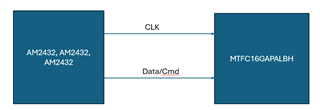Tool/software:
Hi,
Could you kindly review my timing analysis?
We are planning to use the below devices in the upcoming project.

SoC:
Legacy SDR mode:
Tclk(MMC0) = 40ns
Td= Tclk-dV or Tclk-cmd = min(-2.3ns), max(2.9ns)
eMMC : JEDEC Complaint
Tsetup(min) = 3ns
Thold(min) = 3ns
Toutput_delay(min/max)= 2.5ns/13.7ns
Let’s say SoC is driving the clk and command, in that case below will be our timing analysis
Td + Tpcb_data_delay(max) < Tpcb_clk_delay + Tclk - Tsetup_emmc ---------------- eq1
Tpcb_data_delay(max) - Tpcb_clk_delay < Tclk - Tsetup_emmc – Td
Tpcb_data_delay(max) - Tpcb_clk_delay < 40- 3-2.9
Tpcb_data_delay(max) - Tpcb_clk_delay < 34.1ns
Td + Tpcb_data_delay(min) > Thold_emmc + Tpcb_clk_delay -------------------------eQ2
Tpcb_data_delay(min) - Tpcb_clk_delay > Thold_emmc - Td
Tpcb_data_delay(min) - Tpcb_clk_delay > 3-(-2.3)
Tpcb_data_delay(min) - Tpcb_clk_delay > 5.3ns
That means my data or command trace delay should fall between 5.3 ns and 34.1 ns relative to the clock.
Assuming a standard PCB trace delay of 150 ps/inch, achieving a 5.3 ns delay would require routing the trace approximately 35 inches longer than the clock trace — which is clearly impractical.
I feel like I might be missing something here. Could you please help clarify?
Is there any eMMC routing guidelines available with the skew details in any of the TI documentation?

